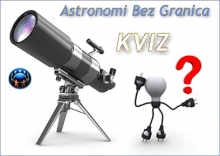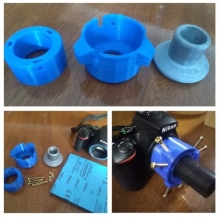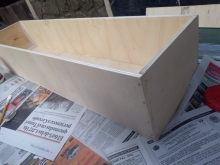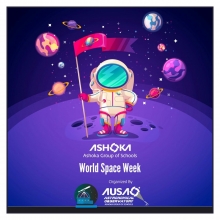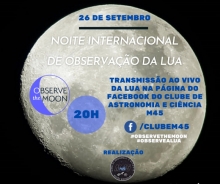Deirdre became interested in astronomy as a young child when she watched the 1969 Apollo Lunar landing. As a child she was given her first telescope, a TASCO 50mm, which was good for looking at the moon and a few larger things but that was about it. Her love of the cosmos stayed with her and, as a young mother of three children, her husband bought her a second TASCO—this time a 70mm telescope with wooden tripod. She was overjoyed that she could now observe the moon, Jupiter and Comet Halley, and share the experience with whoever happened to be in her neighborhood that year. Now the proud owner of an 8-inch Dobsonian, she has a better eye on the cosmos that she translates onto paper and sometimes canvas.
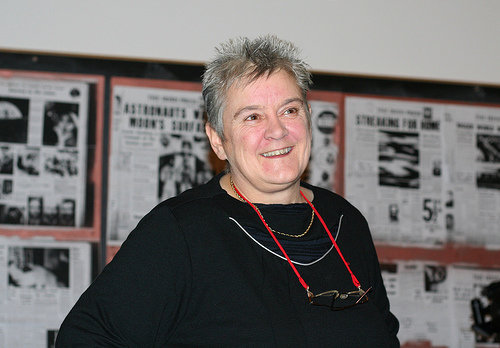 |
| Deirdre in the Dunsink Observatory for an Apollo talk for the International Year of Astronomy – 2009. |
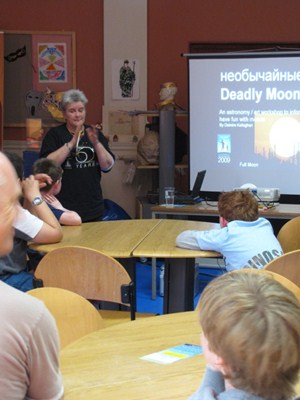 |
| Deirdre holds her Deadly Moons workshop at the National Museum on Kildare Street in Dublin. |
An avid amateur astronomer, Deirdre is involved with several clubs in Ireland, currently holding the position of Vice Chair of The Irish Federation of Astronomical Societies (IFAS). She also assists at the Dunsink Observatory , helping with public outreach events and sometimes arranging for international speakers for the observatory.
For the past seven years she has also been a very active member of the Saturn Observation Campaign , a JPL/NASA outreach program. Currently, at Wicklow Mountains National Park, she conducts an annual presentation on Saturn along with a public viewing opportunity. This partnership event is now in its 5th year and is usually booked four months ahead, often with as many as 250 people attending the star party.
Although her specialty is astronomical sketching of the Moon and the Sun, she would love to attempt more deep-sky objects—but due to the weather in Ireland, there aren’t too many opportunities. To give guidance to others who desire to sketch the Moon, she has co-authored a book; Sketching the Moon: An Astronomical Artist's Guide.
Deirdre joined AWB after her friend and fellow Saturn Observer, Bob Larcher, asked if she had ever heard of Astronomers Without Borders. This clearly piqued her interest because outreach is what she enjoys doing most—whether it’s sharing the sky with people on the street, giving a workshop, or visiting schools. So she promptly wrote a letter to Mike Simmons, and has been involved with AWB since February of 2008.
Deirdre’s involvement with her local community grew from a simple visit with the Principal of a local school. She went to talk to the principal to see if he was interested in her forming an astronomy club in the school. The answer was a big YES. So to get started, she agreed to give a talk once a month to the children and parents. Ongoing, on random evenings when she is free (and the weather is good) and there is something worth looking at in the sky, she simply sends emails to the parents and they bring their children. “It’s a win-win formula, everyone gets to enjoy the sky.”
 |
| The St. Cronans Star Gazers enjoy Deirdre’s revamped soccer ball display from a store window. It was going to be Saturn, but the rings would have been too big to fit in her car, so she decided to paint it like the Moon. |
The club Deirdre started, St. Cronans Star Gazers, is now a full member of IFAS, the first school club in the country to be welcomed under the IFAS umbrella. All it took was one person who enjoyed the sky and wanted to share it with local children and their extended families. Her little astronomy club is also an affiliate of AWB and is planning to participate in many AWB events this coming season. “They are a great bunch of children and parents, and the model of the club is something that could be replicated in any community,” she points out. “And with a bit of luck, the children will not forget what they have experienced. I use drawing as a means for the children to engage with the sky and learn to begin to be astronomers.”
The local paper there, The Bray People, covers almost everything the school astronomy club does, so that also extends the activities into the greater community. The school also hosts a page for the Star Gazers on its website and records all the events and achievement s of the club.
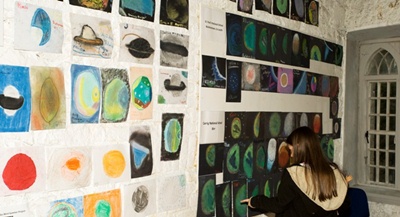 |
| Artwork from the children who participated in the International Astronomical Sketching Exhibition at Birr Castle Science Center is displayed on the walls. |
Deirdre says that “If there is something extra special, like a good view of Saturn or Jupiter, I will drop notes in my neighbors’ doors and they walk down the road and join in—so that extends it to my local community.” It isn’t uncommon for her to have a line of about 80 to 85 neighbors, friends, parents, students and teachers at one session. The town of Bray has felt her impact. “I hope I have encouraged clubs and individuals to be more engaging with the general public. It is an important public service to share the sky with people. Its free, it’s uplifting, it’s educational—all good stuff, all good news.”
Deirdre adds that her favorite part of GAM is “getting the small clubs here in Ireland to engage in public outreach all together with the rest of the world. One people, one sky, never a truer bunch of words said ever.”
BOUNCING OFF THE MOON
The month of April around the world is AWB’s Global Astronomy Month (GAM), which was inaugurated in 2010. Deirdre has been active from the start in many of the GAM Cornerstone Projects, but this year’s action took her literally to the Moon—with a project by Daniela De Paulis and the Dwingeloo (Netherlands) radio telescope team called “OPTICKS.” Two brightly adorned art pieces from two of her kids from the club and two from a local Brownie troop were selected to be sent to the Moon by radio telescope and bounced back. Deirdre noted that the children could still recognize their artwork after its round trip to the Moon, and marveled at how it was so distorted by its long journey there and back. She got to explain how the radio waves worked—and everyone present was amazed at the space-traveling artwork.
Deirdre has developed a strong six-year bond with the Irish Girl Guides and often drops into their meetings to share the sky. Many IGG Brownie troops and Girl Guide troops have attended her talks in their dens or at the Dunsink Observatory. Deirdre has also developed ties with the Wicklow Arts Festival, where she runs her, “Deadly Moons” drawing workshops for them. So far, the relationship looks encouraging and she hopes to be part of the festival in the future.
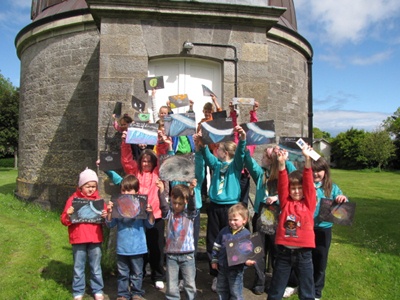 |
| National Drawing Day held at the Dunsink Observatory in 2009 had children from Russia and Ireland participating in this art session. They proudly hold up their masterpieces. |
Currently, libraries all over Ireland engage Deirdre to do workshops and talks at different public events over the course of the year. It’s not uncommon for her to have two to three events a day during Science Week. She also has a strong history of involvement with Blackrock Castle Observatory in Cork, which is in Southern Ireland. Plus, she has a relationship with the Irish educational body Discover Science and Engineering that goes back many years—and they are very supportive of her talks and workshops during Science Week.
Could public outreach go even further? Actually, yes. Deirdre recently found herself starting a telescope lending program for families who have children interested in astronomy. She was given a 5-inch Dobsonian telescope by someone who wanted it to be used, so she loaned it to a family on a neighboring island, about 30 miles off the cost of Ireland. They will use the scope for about a year and then it will be loaned to another family in the future.
Deirdre has recently conducted her astronomical art classes for a minority population in Ireland that have a rich and unique history. These nomadic people, with a history in Ireland going back many centuries, are called the “Travellers” and have many wonderful traditions. As an example of sharing, in one recent class Deirdre was able to tie a story of theirs about “the Lady from the Moon” into her activity.
So the moral of this story is obvious: 1) go where the people are, 2) look for any opportunity to share your hobby and, most important, 3) be flexible.
Read about other National Coordinators featured in National Coordinator Spotlight.









